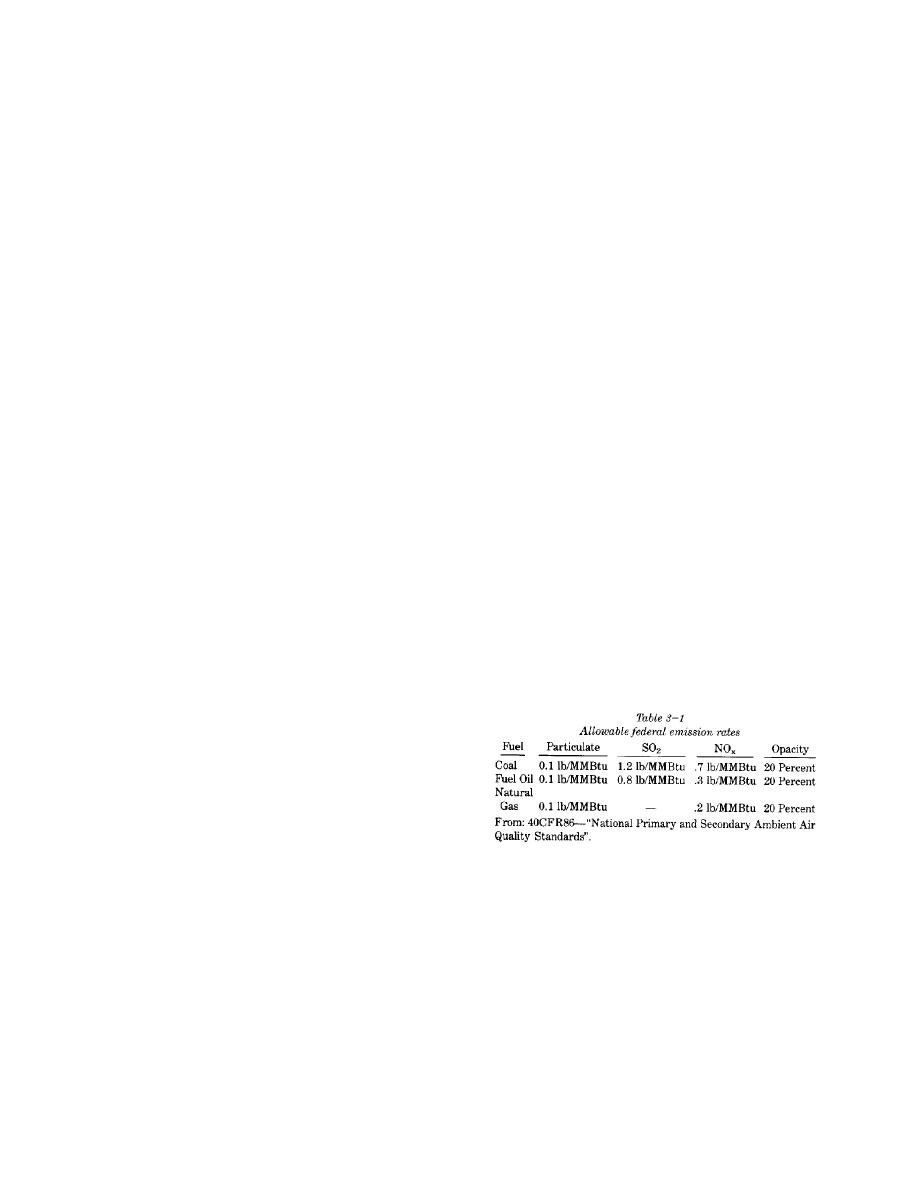
TM 5-815-1/AFR 19-6
b. Types of equipment.
A fuel oil heated above the proper viscosity
(1) Traveling grate stokers. Traveling grate stokers
may ignite too rapidly forming pulsations and
are used to burn all solid fuels except heavily
zones of incomplete combustion at the burner
caking coal types. Ash carryout from the
tip. Most burners require an atomizing viscosity
furnace is held to a minimum through use of
between 100 and 200 Saybolt Universal
overfire air or use of the rear arch furnace
Seconds (SUS); 150 SUS is generally specified.
(5) Municipal solid waste and refuse derived fuel
design. At high firing rates, however; as much
burning equipment. Large quantities of MSW
as 30 percent of the fuel ash content may be
entrained in the exhaust gases from grate type
are fired in water tube boilers with overfeed
stokers. Even with efficient operation of a grate
stokers on traveling or vibrating grates. Smaller
stoker, 10 to 30 percent of the particulate
quantities are fired in shop assembled hopper or
emission weight generally consists of unburned
ram fed boilers. These units consist of primary
combustibles.
and secondary combustion chambers followed
(2) Spreader stokers. Spreader stokers operate on
by a waste heat boiler. The combustion system
the combined principles of suspension burning
is essentially the same as the "controlled-air"
and nonagitated type of grate burning. Par-
incinerator described in paragraph 2-5(b)(5).
ticulate emissions from spreader stoker fired
The type of boiler used for RDF depends on the
boilers are much higher than those from fuel
characteristics of the fuel. Fine RDF is fired in
bed burning stokers such as the traveling grate
suspension. Pelletized or shredded RDF is fired
design, because much of the burning is done in
on a spreader stoker. RDF is commonly fired in
suspension. The fly ash emission measured at
combination with coal, with RDF constituting
the furnace outlet will depend upon the firing
10 to 50 percent of the heat input.
rate, fuel sizing, percent of ash contained in the
3-4. Emission standards
fuel, and whether or not a fly ash reinjection
The Clean Air Act requires all states to issue regula-
system is employed.
tions regarding the limits of particulate, SOx and NOx
(3) Pulverized coal burners. A pulverized coal
emissions from fuel burning sources. State and local
fired installation represents one of the most
regulations are subject to change and must be reviewed
modern and efficient methods for burning most
prior to selecting any air pollution control device.
coal types. Combustion is more complete
Table 31 shows current applicable Federal Regulations
because the fuel is pulverized into smaller par-
for coal, fuel oil, and natural gas. The above allowable
ticles which require less time to burn and the
emission rates shown are for boilers with a heat input
fuel is burned in suspension where a better
of 250 million British thermal units (MMBtu) and
mixing of the fuel and air can be obtained.
above.
Consequently, a very small percentage of
unburned carbon remains in the boiler fly ash.
Although combustion efficiency is high, sus-
pension burning increases ash carry over from
the furnace in the stack gases, creating high
particulate emissions. Fly ash carry over can be
minimized by the use of tangentially fired
furnaces and furnaces designed to operate at
temperatures high enough to melt and fuse the
ash into slag which is drained from the furnace
3-5. Formation of emissions
bottom. Tangentially fired furnaces and slag-tap
furnaces decrease the amount of fuel ash
emitted as particulates with an increase in NOx
boilers, it is desirable to achieve a high degree of com-
emissions.
bustion efficiency, thereby reducing fuel consumption
(4) Fuel oil burners. Fuel oil may be prepared for
and the formation of air pollutants. For each particular
combustion by use of mechanical atomizing
type fuel there must be sufficient time, proper tem-
burners or twin oil burners. In order for fuel oil
perature, and adequate fuel/air mixing to insure com-
to be properly atomized for combustion, it must
plete combustion of the fuel. A deficiency in any of
meet the burner manufacturer's requirements
these three requirements will lead to incomplete
for viscosity. A fuel oil not heated to the proper
combustion and higher levels of particulate emission in
viscosity cannot be finely atomized and will not
the form of unburned hydrocarbon. An excess in time,
burn completely. Therefore, unburned carbon
temperature, and fuel/air mixing will increase the boiler
or oil droplets will exit in the furnace flue gases.
formation of gaseous emissions (NOx). Therefore,
3-2


 Previous Page
Previous Page
